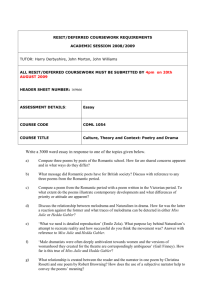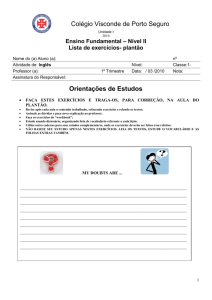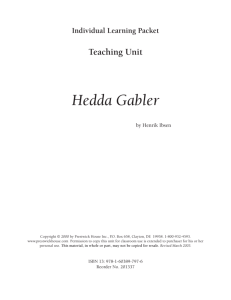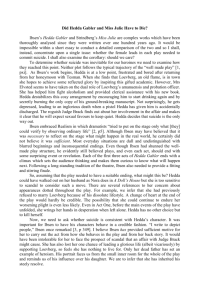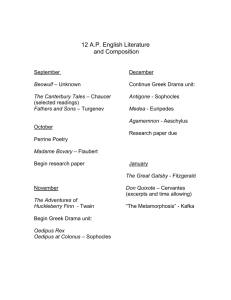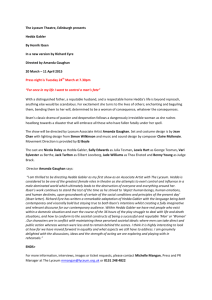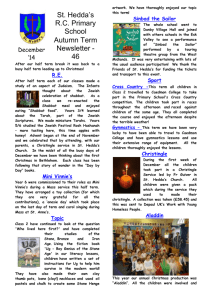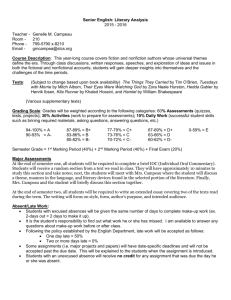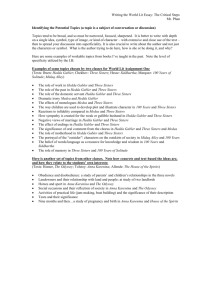Hedda Ed pack outer pdf - Royal Exchange Theatre
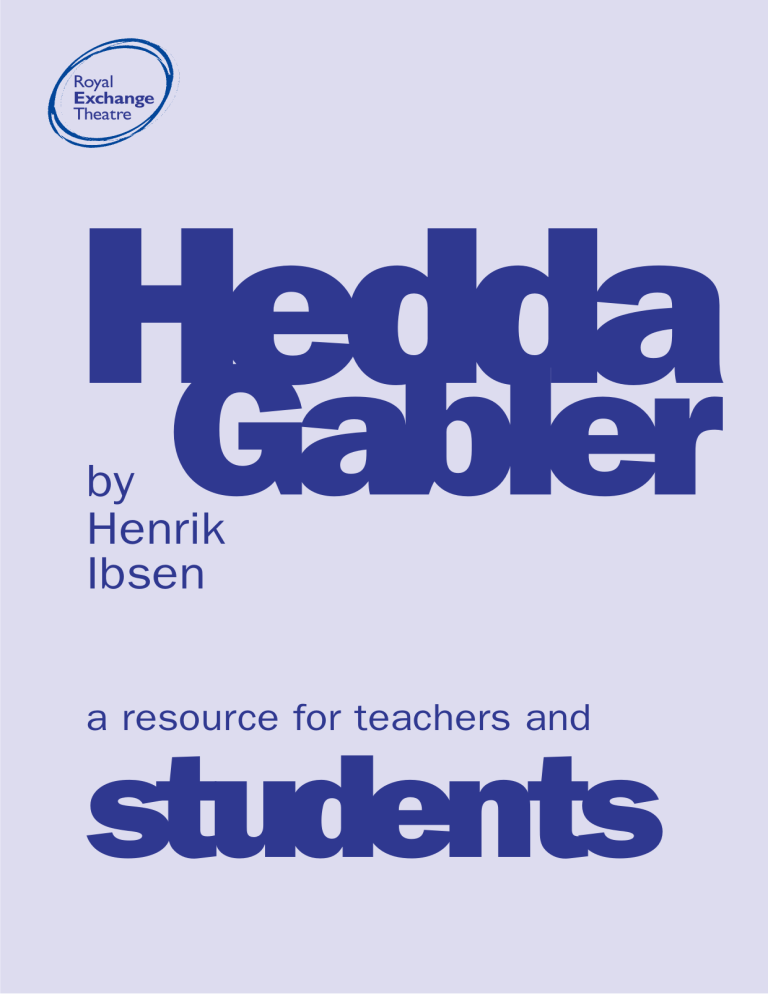
Royal
Exchange
Theatre
Hedda by
Henrik
Gabler
Ibsen a resource for teachers and students
lost the PLOT?
Just in case, here’s a summary:
All the action in Hedda Gabler is set in the drawing room and a smaller room that the audience can, at least partly or occasionally, see into. The action covers the events of two consecutive days.
ACT ONE
• Aunt Juju (Miss Juliana Tesman) visits the new house of her nephew, George Tesman and his bride of six months, Hedda
Gabler. She brings with her a small parcel of George’s slippers.
Aunt Juju has a conversation with Bertha, the maid, who is anxious about her new role and wonders whether she will be able to please her rather grand new mistress.
• George joins Aunt Juju in the drawing room and we learn of the newlyweds’ precarious financial situation and George’s ambitions to become a professor. Aunt Juju tries to discover whether Hedda might be pregnant. George deftly avoids answering.
• Hedda joins Aunt Juju and George in the drawing room. She is brittle in her conversation and is rude about Aunt Juju’s new hat which is on a chair and dismissive of the slippers, embroidered by
George’s other aunt, Rena.
• Thea Elvsted visits to implore the Tesmans to be kind to Eilert
Loevborg who has returned to the city. Despite being married to an older man, Thea is entangled with Eilert and is fearful for him because of his past reputation and his weakness for drinking.
Hedda is manipulative and insincere in her attention to Thea
Elvsted in order to get her to confide.
• Judge Brack visits and they talk about the Tesman’s financial situation and Eilert Loevborg who is also an academic and possibly in competition with George for the professorship.
ACT TWO
• Later the same day, Judge Brack returns and interrupts Hedda who is playing with her father’s pistols. She fires aimlessly through the open French windows.
• Hedda and Judge Brack indulge in a sometimes flirtatious but often loaded conversation about Hedda’s marriage, her expectations and the nature of their friendship. Brack proposes a triangular relationship between Hedda, George and himself.
• George joins them and there is discussion of Aunt Rena’s deteriorating health. Hedda is dismissive. He disappears to work and later reappears in evening dress ready to attend a bachelor party that Judge Brack is hosting.
• Eilert Loevborg arrives and he and Hedda indulge in a hushed and intense conversation in the drawing room whilst George and the Judge drink cold punch in the other room. We learn of
Hedda and Loevborg’s past involvement.
• Thea Elvsted joins them and Hedda is ruthless and unkind in manipulating the conversation and betraying Thea’s anxieties.
• Eilert Loevborg changes his mind about the arrangements for the evening and decides to attend Judge Brack’s party and promises to return for Thea later in the evening.
…one part of
(Hedda’s) problem is that her basic instincts struggle against a perception of herself as someone too good, too pure, too civilised, too social to have sex.
Rober t Ferguson in
HENRIK IBSEN, Richard
Cohen Books 1996
ACT THREE
• Thea sits awake in the early hours of the dawn whilst Hedda is asleep on the couch. Neither George nor Eilert Loevborg has returned from the party. Hedda sends Thea upstairs to sleep and
George appears. He talks about Eilert’s writing and the manuscript that he has rescued after it was dropped by a drunk
Eilert. George speaks of its quality and his own professional jealousy.
• George reads a note from Aunt Juju that was delivered by Bertha, the maid, a little earlier. He learns that Aunt Rena is dying and leaves to visit his aunts’ house.
• Judge Brack arrives and tells Hedda that Eilert has been arrested after a fracas at Mademoiselle Danielle’s "establishment" where he and the Judge ended up after the party.
• Upon Judge Brack’s departure, Eilert arrives interrupting Hedda’s inspection of the manuscript, which she hastily hides in the drawer of her writing desk. Thea joins them. Hedda does not admit to having the manuscript that Loevborg claims to have destroyed.
• Upon Thea’s distressed departure from the room, Hedda and
Eilert entertain a difficult and charged discussion about the loss of the manuscript and Eilert’s fall from grace. Hedda gives him one of her father’s pistols and tells him to take it and go and to "do it beautifully".
ACT FOUR
• In the evening of the same day, Aunt Juju arrives in the darkened drawing room to visit Hedda in the wake of Aunt Rena’s death.
She announces that she will fill her loss by looking for someone else who is an invalid and in need of care.
• After Aunt Juju’s departure, Hedda confesses to George that she has burned Eilert Loevborg’s manuscript. She insincerely claims to have done so out of love for her husband. George is both joyous at this possibility of his wife’s adoration and discomforted by the enormity of what Hedda has done.
• Thea Elvsted arrives in a state of distress because Eilert Loevborg is missing and she has heard rumours that he is in hospital. They are interrupted by Judge Brack. He announces that Eilert
Loevborg is in hospital and that he is dying having shot himself through the breast. Hedda’s response is evidently odd and unnerving.
• George Tesman and Thea Elvsted vow to rewrite the manuscript from the notes that Thea Elvsted has saved and they move through to the other room to immediately begin this project.
• Judge Brack confronts Hedda with the truth, which is that Eilert
Loevborg did not commit suicide. In fact he shot himself accidentally "In the – stomach. The – lower part -". He also challenges Hedda with the fact that it was her pistol that Eilert
Loevborg used. There is a sinister element to the Judge’s suggestion that there will be no scandal "…as long as I hold my tongue".
• Hedda leaves the drawing room where George and Thea Elvsted have earlier repositioned themselves in order to use the writing table. A frenzied dance melody is heard from the piano. George asks her to be quiet in respect of Aunt Rena and Eilert Loevborg.
• The report of a gun is heard and when George pulls aside the curtain he discovers Hedda lying dead on the sofa. She has shot herself in the head. The play closes on Judge Brack’s exclamation
"But good God! People don’t do such things!".
Ibsen’s wife, Suzannah, was a Theosophist who believed that after the writer’s death he lived on invisibly within her. So devout was this belief and so much did she want to please Ibsen, that she never altered the placing of anything in their home for the eight years that she outlived him. She knew that order and habit were intensely important to the man and honoured that in her maintenance of the house.
who’s who in
HEDDAGABLER?
Ibsen is very detailed in his descriptions of characters and gives us some very precise physical details. It is unlikely in any production that the casting can meet the exact suggestions that the playwright makes but what these suggestions can help us with, alongside the events and behaviours of the people, is some understanding of the personality of the characters. Some elements of these descriptions have been included in the following brief biography for each role in HEDDA GABLER.
HEDDA GABLER
(Amanda Donohoe) –
Married to George Tesman for just six months, Hedda is the daughter of a wellknown General. She is described as being twenty-nine years old, distinguished and aristocratic in appearance and that she carries an air of cold, calm serenity. As the play unfolds, we learn that she is bored in her brief marriage to George Tesman and that their courtship partly hinged on the admiration of the house where they now live and which once belonged to the late Prime
Minister. Her declared liking of the house was apparently dishonest and she now claims the place to have "…the odour of death about it". She is curt in her dealings with Julia Tesman (Aunt Juju) who along with
Aunt Rena, brought up the orphaned George. Hedda entertains Judge Brack with a mixture of intimacy and flirtatiousness that becomes increasingly intense and edgy. Her real curiosity, however, lies with the academic Eilert Loevborg, with whom she has had a close friendship in the past. In recapturing some of the threads of this relationship, Hedda uses and manipulates the less worldly Thea Elvsted, herself smitten with Eilert. Hedda’s discomfort in her marriage extends to a distress about the idea of pregnancy and motherhood and she denies that her subtly more rounded appearance is to do with such an expectation.
GEORGE TESMAN
(Simon Robson) – In his early thirties, George is establishing his future as an academic and is hoping for a promotion to a professorship. Briefly, this future is clouded by a suggestion that Eilert
Loevborg will compete with him for this post and this casts a passing shadow over his happiness at his luck in wooing the beautiful Hedda and the establishment of their future in their new house. Ibsen depicts George as being youthful, plump and having an open, round, contented face. George Tesman is aware that, in being married to
Hedda, "…quite a few people in this town wouldn’t mind being in my shoes". He is solicitous in his manner and tries hard to please Hedda although this is sometimes difficult because of her indifference to
George’s past and his relationship with his aunts,
Juliana and Rena. He sometimes cajoles Hedda into a kinder approach to people or overlooks her more indiscrete remarks.
JULIANA TESMAN
(Avril Elgar) – Aunt and guardian to the orphaned
George, Aunt Juju lives with her sister, the dying
Aunt Rena. Described as being of a pleasant and kindly appearance, Aunt
Juju is proud and indulgent with George and is optimistic that he and his new wife will soon establish a family, a hope that she coyly quizzes her nephew about. Her relationship with Hedda is compromised for although Aunt Juju is at pains to please her, Hedda is impatient and sometimes sharp in her responses and comments; in part this may be to do with their very different social backgrounds and aspirations.
JUDGE BRACK
(Terence Wilton) – A friend of both George and
Hedda, Judge Brack has been responsible for organising the acquisition of the house and overseeing the couple’s finances whilst they were abroad for six months on their honeymoon. He is a persistent visitor to the
Tesman house and indulges in an increasingly calculating flirtation with Hedda. He is also the person who brings news and gossip to the house; initially this is about the possibility of Eilert Loevborg’s competition for the professorship whilst later it is about the events in
Loevborg’s downfall. It is suggested that he is well built and elastic in his movements and that his eyes are lively and humourous.
EILERT LOEVBORG
(James Clyde) – An academic and writer,
Eilert Loevborg has a disreputable past that appears to hinge upon his drinking. In recent times he has become something of a reformed character and has recently published a scholarly study that has gained considerable critical acclaim. There is another manuscript ready for publication with which he had the help and commitment of Thea Elvsted. Whilst he had considered entering the competition for the professorship, following the success of his book, he has withdrawn observing to George that he only wants "to defeat you in the eyes of the world" .
He is pictured as being lean and a little haggard, as looking older than George despite being of the same age and that he is quite elegantly dressed in what appears to be a fairly new suit.
THEA ELVSTED
(Kate Isitt) – Mrs Elvsted has become increasingly involved with Eilert
Loevborg despite being a married woman with stepchildren. Indeed the relationship started when
Loevborg came to be their tutor. Working alongside Loevborg as secretary and helping with his research, Thea Elvsted feels intense about the man and his work. She comes to the Tesman’s house having followed Loevborg to the city because she fears that the temptation of drink will lead him back to his old, troubled ways. Ibsen sees her as a delicately built woman with a frightened and questioning expression. Thea Elvsted is slightly wary of Hedda having known her at school and remembering her as being intimidating and unkind.
Nonetheless she allows herself to be flattered by
Hedda and Thea becomes frank and careless with her confidences, which Hedda then uses against her.
BERTHA
(Eileen Essell) – Bertha has come to George and Hedda Tesman’s house to serve as their maid having previously worked in the household of Aunt Juliana and Aunt
Rena. She is fearful that she will not be able to meet Hedda’s expectations; an anxiety that proves true.
Around the time that he wrote
HEDDA GABLER,
Ibsen indulged in one of his platonic flirtations with young women. The woman in question was Emilie Bardach and she wrote of this experience:
“Now it is true love. The ideal he wrote about before the experience.
Now he will be the poet of pain and denial. But happy to have found me, the most beautiful, the most wonderful. Too late. How pathetic
I feel myself, that I cannot throw myself into his arms – and then the obstacles once again – reality, the years of difference, his wife, his son – all this separates us.”
approaches to
HEDDA GABLER
The role of the director in modern western theatre tends to pivot on two central tasks. The first of these is to shape the concept of the production and the second is to bind the entire company in sharing and realising this approach to the
In part this shift in approach may be because the radicalism of this naturalistic play has become common-place in the way that we explore and understand the effects of society upon the individual. It may also be that it is easier for us to play. We sometimes talk of this concept as being a reading of the play and by this we mean the way in which we take a particular understanding from the action and themes.
HEDDA GABLER is rich in possibilities and a vast range of approaches have been explored since it was first staged in
1891. One of the central strands is the tragedy of Hedda
Gabler herself, an alienated and isolated woman who makes an uncompromising stand against the values of the conventional and ordered society in which she finds herself.
Historically there has tended to be a broad shift in how this has been interpreted. Earlier productions and audiences sometimes tended to experience Hedda’s alienation as a wilful, almost evil, confrontation by a desperate and disturbed woman. The values of the bourgeois world of the
Tesmans’ were seen as desirable and civilised and the disorder and destruction of
Hedda’s perceptions and actions as deviant and unhinged. A critic of the period of the play, writing in
THE SATURDAY REVIEW, found the idea of staging this drama so distasteful that he observed, "We do not mean to say that there are not, unhappily, Hedda Gablers and George Tesmans in
'real life'. There are; but when we meet them we take the greatest pains to get out of their way, and why should they be endured on the stage?".
In latter day productions, the readings of the play tend to be more sensitive to Hedda’s plight of being trapped in this
WHY NOT?
accept a critique of a past era than it is to grapple with our own time. It is not unusual to read reviews of modern, confrontational drama that say much the same thing about our here-and-now as the critic writing about HEDDA
GABLER in THE SATURDAY REVIEW.
Ibsen, writing in a letter to the French translator Moritz Prozor in December 1890 declared, "The title of the play is
‘Hedda Gabler’. My intention in giving it this name was to indicate that Hedda as a personality is to be regarded rather as her father's daughter than as her husband's wife. It was not really my intention to deal in this play with so-called problems. What I principally wanted to do was to depict human beings, human
• Write a review of this production that explores the way that the performance, the setting and the theatre shapes the relationship between you as an audience member and the world of Hedda Gabler.
• Explore a different era in which you might set a production and research the social conditions of the time and make notes about the connections between the values and beliefs of that society and those that are explored in this play.
• Discuss the way that respectability shapes our behaviour and expectations in contemporary society.
See if you can identify role models who have in the past confronted convention but now seem to lead a moderate and conservative lifestyle. Do you think that there is greater happiness in living in a secure and ordered world or in taking the risk of breaking boundaries and discovering things that were previously outside your expectations?
stifling petit bourgeois world and balance her behaviour against the claustrophobia of the metaphorical enclosure of the drawing room and the anteroom where the entire action emotions, and human destinies, upon a groundwork of certain of the social conditions and principles of the present day.".
The commitment here is to a realist and naturalistic approach for which Ibsen is credited with being a founding voice. In general, productions tend to be loyal to this style and method. A production of the play with Janet Suzman (1977,
Duke of York’s’ Theatre,
London) typified the detail of setting and performance that we associate with naturalism.
The proscenium arch stage was sombre with plush velvet, dank colours and Victorian detail, epitomising the confinement and entrapment felt by Hedda and against which she rails.
This confinement finds a further emphasis in Hedda’s revulsion and resistance at the notion of pregnancy, which is persistently hinted at but never quite confirmed. She cannot quite buckle under this domesticity and familial expectation. There is allure for Hedda in the romance of a crown of vine leaves; exhilaration and beauty in the power of the pistols.
takes place. It is interesting that Aunt Juju (Juliana), in reminiscing about the young Hedda, remembers her out-ofdoors and liberated, "You remember how we used to see her out riding with her father? In that long black skirt?
With the feather in her hat?".
Yet her present circumstances are contradictory and her attitudes and feelings in conflict; if we see Hedda as trapped against her will, what do we make of the moment when Hedda herself complains, "Oh that maid’s left the French windows open. This room is flooded with sun." ? Although
Hedda rails at her enclosure in this world, she is also partly responsible for being there.
There have been a number of notable productions that have radically departed from the realist or naturalist agenda of
HEDDA GABLER. Inevitably there is a risk in taking such steps and a need for a strong intellectual argument and justification if this tactic is going to be employed.
Meyerhold (1906) stripped the play of its references to time and space and symbolically costumed the characters by colour; George Tesman, for instance was dressed in grey and
Thea Elvsted in pink. Hedda occupied a central art deco
throne, covered in white fur, whilst the other actors came and went through lace curtains. Often the lines were delivered rhythmically and directly to the audience and followed by long silences. The dialogue, and an embedded denunciation of society, became the focus of the performance.
More recently (1990) Downstage Theatre in New Zealand performed at the first International Ibsen Festival in Norway and offered a production directed by Colin McColl where the action took place inside Hedda’s mind and became an exploration of a journey into madness. This was a quest for psychological truth pushed to a theatrical boundary. Lines were often delivered three or four times and a young Maori actor who played Loevborg, appeared on stage in Maori ceremonial dress to deliver a Maori death ritual following
Hedda’s burning of the manuscript.
Another production staged at the Chrysler Museum Theatre in Virginia employed a musician who intermittently played pieces from Brahms and Schubert on a grand piano centre stage whilst the actors switched between naturalism and high melodrama. The set included the actors manipulating a real doll’s house as a metaphor for the scaled down world in which Hedda now finds herself.
Some people argue that drastic departures from the conventions of a play such as HEDDA GABLER devalue the authenticity of the script. However, what this range of productions does is illustrate the fact that we can shape quite different readings that then have repercussions for how we might stage the play.
WHY NOT?
• Discuss the different readings that you can find in this play. To what extent do you think this is a study of the psychology of Hedda or a study of the society of the time? Do you think the playwright employs any particular perspectives in his writing of the play such as a feminist voice? In making your decisions, you must be able to justify the ideas with evidence from the action of the play.
• Choose your preferred reading of the play and make notes towards a production of the play. As the director, how will you make your understanding of the play evident in the action, performance and setting?
• Design a poster for your production of HEDDA
GABLER in which the images or icons that you use are symbolic of the reading and approach that you have decided upon. Think hard about your audience and how they will be able to understand the themes from the design of your poster.
HEDDA GABLER at the Royal
Exchange Theatre, 2001
Braham Murray, who directed this production of HEDDA GABLER, describes the play as “...a frightening, terrifying journey…the darkest of Ibsen’s plays”.
For the director and the company, the central thread in this play is the tension between bourgeois middle-class respectability and the constraints upon the fulfilment of an individual. Discussing this in a production meeting, Braham suggested that, at its extreme, this stifling gentility of good behaviour and social respectability can poison and corrupt lives. This is the riddle that explains Hedda for she has taken the safe route of marriage to a respectable and perhaps boring man and yet the lure of passion persists. She sees beauty in danger. Yet there is also her brittle attitude to sexuality and love. Hedda flirts but appears not to quite to commit herself to the men around her and expresses distaste for the acknowledgement of love between herself and George Tesman, refuses to acknowledge the partnership of the honeymoon and is repulsed by pregnancy and parenthood. Braham Murray suggests that there is a reflection here of Ibsen’s own platonic flirtations with women that occurred intermittently throughout his life. Here he courted the thrill and danger of extra-marital liaisons but never committed himself to the underlying sexuality of the relationships.
Braham explains that very early in the planning of the production, he and the designer, Liz Ascroft, took the decision to shift the period to just post World War 2. The pivot for this decision was to avoid the Victorian era and to jerk audiences familiar with the play into a new relationship with the action and themes. This era of
He tried to show contemporary audiences that even without God it was worth trying to live at a moral level…
there is a way in which people held on to a past for security and continuity.
Rober t Ferguson in Henrik Ibsen,
the 1940s was, Braham suggests, the last epoch of the conventional bourgeois morality that the play explores.
Interestingly, too, it is an era in which those values have been swept away by the consequences and the upheaval of war yet
Richard Cohen Books 1996
At the heart of this production was the director’s ambition to make the excesses of Hedda’s behaviour and their unsympathetic consequences feel sympathetic and to highlight our own role as an audience, as voyeurs to the action and judges of the events.
an actor in search of a CHARACTER
Terence Wilton discusses a Stanislavskian approach to the character of Judge Brack
Getting Started
The beginnings of discovering Judge Brack have involved the actor Terry Wilton in three separate and rigorous readings of the script. In the first focused read through, he makes a note of everything that every other character says about his role. In the second reading, he looks for everything his role says about the other characters. Finally he establishes what it is his character says about himself. Throughout this process, and through the whole rehearsal period, Terry carries a notebook with him, jotting down notes and thoughts about his character.
In his three initial readings of the play, Terry is building a comprehensive sense of what Stanislavski calls the given circumstances for Judge Brack. Each fact of his life and behaviour and history is carefully examined and internalised as part of being Brack.
The obvious facts are easier to gather but the intensity of reading the script from three perspectives allows the actor to also pick up on the small truths; those small truths can often illuminate something major about the personality of the role. Think about the way Judge Brack often sidles into the house through the garden. Does this reveal a slightly underhand or calculating personality that likes to manoeuvre his ambitions and needs secretly? Terry speaks of this as the building of a patchwork quilt in which he slowly reveals the archaeology of the character to himself, the actor. It means he is well under way before the first day of rehearsal.
Of course, the process may also raise questions for which there is not an immediate answer; the truth of this may be investigated and agreed later in discussion with the director and the company. A good example of this is the truth of the relationship between Judge Brack and Hedda. Judge Brack is flirtatious and manipulative with Hedda and talks of establishing a triangle in their friendship. "Is this just sex talk?" asks Terry, "Or is there a past here? Have they had a relationship somewhere in the past that is more than a friendship?" The answer to this question may well have consequences for the way in which Hedda and
Judge Brack interact with one another.
In Rehearsals
Speaking before the rehearsals began for this production of
HEDDA GABLER, Terry notes that he expects that they will spend the first two weeks or so in the concerted and concentrated task of dividing the action up into what he refers to as beats and actions . Each identified beat has an associated intention and action; this is Stanislavski’s device of units and objectives. Here the play is broken down, partly into manageable chunks for investigation, but more clearly it is so that each moment is defined by a particular objective, is explored and given a motive. Within such an exercise, the questions that the actors might ask of themselves as the characters include "Who am I?", "Where am I?", "What do I want?", "How am I going to get it?". As Terry observes, "What this means is that nothing is generalised, everything is detailed."
WHY NOT?
• Choose a character from HEDDA GABLER and make comprehensive notes about the given circumstances provided by the script. You might like to employ Terry
Wilton’s strategy of reading the play three times from the suggested points of view.
• Identify the units and objectives for one scene in which your chosen character appears. Remember that the unit is defined by the objective (a verb) and that the units need to be coherent; don’t break the scene down so intensely that it is difficult to manage the shifts and changes in performance.
• See if you can establish questions about your character that are not necessarily answered within the script. You might like to discuss these uncertainties with other people working on the play and see if you can agree the circumstances.
• Work in a group to consider the appeal or otherwise of the characters in this play. There are people such as George
Tesman, Thea Elvsted and Aunt Juju who are seemingly
"good". How do we know this of them? Hedda, Judge
Brack and Loevborg are more complex and darker characters. What traits do they share? What entangles them as people? Which of these characters appeals more to you? What judgements can you make of them as moral beings and what judgements do you make of them in terms of the way they engage you as an audience?
The Character’s Physical Centre
"You must not copy passions or types. You must live in the passions and types. Your acting must grow out of your living in them."
Constantin Stanislavski in AN ACTOR PREPARES
One of the challenges that Stanislavski presents to an actor is how to discover the physical centre of his character; in this instance the physical centre of Judge
Brack. The obvious example that Terry gives of this process is that of a character who is hysterical and is thus likely to have a physical centre high in the chest.
Stanislavski talks about the way in which our musculature can effect and constrict our performance; in this instance the actor might actually strive for just that kind of constriction. Here the physical centre is that of the character, not of the actor. The actor comes to live in another physicality. In thinking about Judge Brack,
Terry’s early speculation about the character’s physical centre is that it is possibly low in the body, in his groin, implicated in his sexuality.
Sometimes this physicality is contradictory and Terry speaks of the "above the table" and "below the table" aspects of a character. He played Pastor Manders in
Mike Alfreds’ production of Ibsen’s play GHOSTS.
Manders "above the table" was bullish, insistent,
controlling, brow-beating, almost monstrous. Yet under the table, Manders was a moral rabbit, lacking in integrity. If you think about it, these contradictions exist in all of us. Think of the person who presents to the world as aloof and cool whilst suddenly revealing deep insecurity and shyness; we might outwardly face the world with a physical mask that slips to reveal surprising truths. In his role as Judge Brack, Terry has to explore the man who is an upright and respected judge and who enjoys the confidence of his position in society. Yet he is also the man who does not want to be observed sidling into the house through the garden, conducting sly conversations with
Hedda.
Stanislavski extends this concept of a physical centre with the sense of tempo rhythm whereby the inner life of a character is externalised by the quality and pulse of his or her presentation. In Terry’s example of an hysterical character, we might expect an angularity, an uncomfortable, sharp erratic tempo rhythm. We will see this in the body and hear it in the voice. In Pastor Manders we might experience a confident, verging on aggressive, tempo rhythm. Ibsen describes Judge Brack as well built and elastic in his movements and that his eyes are lively and humorous. This generality is a rough starting point for the character and the development of a tempo rhythm. The real tempo rhythm will be established alongside an understanding of the units and
WHY NOT?
• Try ways of using your body to portray confidence or insecurity, elation or depression. Monitor the way in which you hold and carry yourself and try to establish where your physical centre is – what happens to you spine, chest, shoulders, neck or arms as you take on the mantle of this personality?
• Explore another character from Hedda Gabler and determine the personality that informs their physical centre. What does this do to their presentation and movement? Try this out with a partner in a scene from the play.
• Look at contrasting excerpts that involve Judge
Brack and try to decide upon the difference in tempo rhythm that might be employed. Either find a way of marking it visually on a graph, or perform it. Try different approaches and see which feels appropriate.
• Explore what happens to your body when you deliberately tense groups of muscles. What does it do to the quality of movement and to the delivery of lines? What do you imagine this tension will do to your stamina over time?
objectives, the process of building role and understanding the character’s overarching super objective and the through line of the action. However, the actor will also persistently renegotiate moments of tempo rhythm to accommodate the moments in the action; Judge Brack in male camaraderie with Tesman is likely to employ a different tempo rhythm to that which we see when he is wooing
Hedda.
An Actor Prepares
"In the creative process there is the father, the author of the play; the mother, the actor pregnant with the part; and the child, the role to be born." Constantin Stanislavski in AN
ACTOR PREPARES
Terry maintains a good level of fitness to meet the demands of being an actor.
Stanislavski stresses the physical preparation of an actor for playing a role and is quite specific about how undue tension can affect breathing and vocal delivery. Part of this preparation is in concentrated warm-ups and exercise before a rehearsal or a performance with a conscious attention to muscle groups and the rhythm and depth of breathing. It is also the case that a season of performances is intense and demanding; so fitness is very necessary.
In approaching a role Terry also reads widely. In looking at this play he explored biographies of Ibsen, read works by the playwright and read generally around the era and
Norwegian culture. One of the interesting things that he encountered was the fact that the police regulated brothels in Norway; it was an unspoken contract that respectable men such as
Judge Brack could visit Mademoiselle
Danielle’s establishment with impunity.
That is, of course, like Eilert Loevborg, you created a scene and made your presence and behaviour public.
Research is vital to the Stanislavskian method. He says "You should first of all assimilate the model…You study it from the point of view of the epoch, the time, the country, condition of life, background, literature, psychology, the soul, way of living, social appearance; moreover you study character, such as custom, manner, movements, voice, speech, intonations. All this work on your material will help you to permeate it with your own feelings. Without all this you will have no art." Constantin Stanislavski in AN ACTOR PREPARES
the DESIGN
The Space
Liz Ascroft is designing both the set and the costumes for this production of HEDDA GABLER. Very early in the process of planning and discussion, she and the director, Braham
Murray, established the decision to shift the action from the
Victorian era to the late 1940s. This was the catalyst to Liz’s research and thinking, out of which the detail of the costume and setting emerged.
Alongside this, Liz explains, she had constantly to hold on to the very special relationship that the in-the-round nature of the Royal
Exchange
Theatre demands. It is a powerful space for this play because it highlights what is going on in our heads as an audience, and in the minds of the other characters around
Hedda.
Hedda, in the words of the director is "a rare, powerful, intelligent and exotic creature" .
The audience and the other characters can only watch and try and impose some sense upon her.
But Hedda resists; she will not conform. We are voyeurs and her judges, much like the society within which she lives.
The exposure to which Hedda is subjected is made more intense by the fact that in this theatre space we look in from all angles and there are no dark corners in which she can hide. Even the small room that adjoins the drawing room of the main action is open and available for us to see everything. This looking in on the action prompted Liz
Ascroft to remember and dig out two pictures that somehow had a resonance for her understanding of HEDDA GABLER.
One of these pictures is of five exquisitely gowned women dancing before tall windows; the other shows a single dancer also seen through a window. Liz says she does not know why this inspiration occurs to her but it is the starting point of realising the birdcage within which the play will eventually be set. The women trapped behind glass, Hedda behind the lattice of bars. And with this comes a central motif of Hedda as an extraordinary and vibrant bird.
The Process
Initially when setting to work on designs, Liz reads, reads and rereads the script so that she knows the play inside out. She says that by the end of the process she has a very different understanding of the play. On a first read through Liz says she wanted to tell Hedda to "get a grip" ; at the end of the process she was full of admiration for her bravery. There is an aspect to designing a play like this that Liz finds quite daunting and that is because it is a classic of the theatre and comes with a welter weight of experience and opinion that can feel intimidating. "It’s like designing MIDSUMMER
NIGHT’S DREAM or HAMLET," she says, "where you face all the others before you and there is so much material. You have to undo your thinking and set it all aside so you can find your own voice for the play."
The next stage in the research process is reading around
Ibsen and also the period that the director and she have agreed upon. The research on the period of the late 1940s centred on the work of designers such as Christian Dior,
Jacques Fath, Pierre Balmain and Christobel Balenciaga.
What Liz was interested in was the history rather than the actual designs. Dior was insistent on celebrating femininity and ditched the tailored, shouldered outfits of the war years with their use of utilitarian cloth and sober cut. This was an explosion that wanted to over-turn the restrictions of rationing, to indulge in fulsome and billowing skirts, to celebrate the body, to accentuate bosom and hips. For Liz this felt exciting and an evocative mirror of Hedda’s desire for
Occasionally it is claimed that Ibsen was in some senses a feminist writer. Whilst it is true he was concerned with issues that affected women he did not consider himself to be a particularly feminist thinker and saw himself as interested in universal issues of human liberty rather than convention and pressure from an orthodox society.
Indeed, some women attacked
Ibsen for the character of Thea who, they suggested, is a woman who sacrifices herself for men, firstly as a muse for Loevborg and than as an accomplice for George
Tesman in redeeming the burnt manuscript. Ibsen approved of
Thea and saw her as an exemplary example of womanhood whilst
Hedda rejects the possible roles of wife, mother or accomplice in her husband’s work.
excitement in the context of her sober marriage and her place in the achingly respectable household.
What Liz also unearthed was an extraordinary history of disapproval from a group of women who styled themselves as an anti Dior group and called themselves The Little
Below the Knee Club .
Scandalised by the excess of these new fashions, members of The
Little Below the Knee Club would go into shops and take scissors to the voluminous hemlines. They would attack women in the streets and throw eggs at models on the catwalks. These women saw these fashions as an affront to the temperate world of post war
Europe. Somewhere here was even more material to explain Hedda, to contrast her flamboyance with the domesticity of Aunt Juju or the tameness of Thea Elvsted.
Images, ideas and jotted notes ended up in Liz’s sketchbook. At this stage she was not concerned with the detail of design but exploring a kaleidoscope of ideas and images that will inform her thinking. Amongst the images are the beginnings of setting ideas that are offered in what she calls "scribbled drawings". Armed with these boards, Liz then had a meeting with Braham
Murray, to flesh out the substance of their thinking and to seek agreement for the way forward.
A Time and a Place
When you see the production, you might notice that the sense of the late 1940s is not there in the setting. But like all things in the construction of a play, there is a reason and an intention behind the fact that the two rooms seem to come from an era long before the fashions of the chosen time. The house has been furnished in the honeymoon absence of George Tesman and Hedda and this has been undertaken by Judge Brack and draws on the influence of people such as Aunt Juju and the history of the family.
What the rooms need to intensely reflect is the tastes and values of the past, of the other people and the history against which
Hedda rails.
Liz Ascroft came across a photograph that offered the stimulus for her thinking of the detail of her setting for HEDDA GABLER.
The room, constructed and furnished in the eighteenth century, offered everything she wanted to achieve for it gave her the formality that suggested that you needed to behave in a particular way, to observe the legacy of the past. She observed "It was like those formal photographs of the
Royal family where you know they are modern, living people but they are sitting in these surroundings which seem to weigh down on them, to remind them that they are also in the past and that there are those expectations of them. They have to conform."
WHY NOT?
• Research the period of the late 1940s as Liz Ascroft did.
Find out about, and pay particular attention to, the work of designers such as
Christian Dior, Jacques Fath,
Pierre Balmain and
Christobel Balenciaga.
Photocopy and collect images and notes and bring these together on your own design boards to help you understand the process that a theatre designer undertakes.
• Find your own metaphor, other than a cage, for realising the idea of
Hedda’s entrapment in her marriage and the bourgeois respectability of the play.
Identify a period that you feel fits this idea and collect background information on the social history that justifies your thinking and sets you off on the process of designing a set and costumes for the characters.
The room of the photograph still exists, maintained in aspic. Liz was delighted when an opportunity arose to visit the room whilst on a trip to New
York. Had she been designing for a film, Liz says she would have just lifted the setting as it was.
But she was designing for the theatre and for a theatre in-theround. She had to hone down the detail and to make sure that each item of furnishing used was focused and held meaning for the play. In part these decisions are about budget and about space but they are essentially about making sure that the characters and the audience share in a world where there is a refined significance to every piece of furniture and a visual, aesthetic connection between everything. She describes this process as becoming ever more skeletal.
On seeing the room in concrete reality,
Liz began to be able to make links between the inner furnishings of her set and the caged structure that defines the boundaries. In part this has been in the use of colour and she extended the metaphor of the bird in plumping for a thematic use of an eggshell colour
(grey/blue/green) and of tying the detail together with use of gold which occurs in the trimming on chairs, accents on furniture, the bell push, the door handles and on General Gabler’s portrait. Liz describes this as the process of making a physical contact between the walls and furnishings.
WHY NOT?
• Select a photograph or a painting of a room that you feel is ideal for setting the play HEDDA GABLER and make notes on how you would adapt the detail of this room for use in a specific theatre space that you know. Go through the script as you do this and pay close attention to the instructions offered by Ibsen and the action as it occurs in the play. What needs to be there for practical use? What needs there to be there to enhance the meaning and the aesthetic of your production?
• Put together a design board that deals purely with colour, pattern and texture. How will you use these to create mood and interest in your setting and to what extend will they bind the entirety of the setting that you envisage. Make brief notes to justify your decisions.
• As an extension of this idea play a game that Liz herself sometimes uses when she is approaching a play. Choose a character and ask yourself: If this person was an animal, what animal would they be?; If this person was a piece of furniture what piece of furniture would they be?; If this person was a meal, what meal would they be?
• Try this also with some categories of your own and take it further by writing a short paragraph on each comparison.
Dressed to Kill
Before the play goes into rehearsal, the technical company, designers and director meet together to begin to firm up the technical demands that the production is going to make upon space and expertise. At this stage there is a working model of the set and detailed designs for costumes. Liz describes the designs as being pretty well together by this stage and "sort of like wet concrete, not gone off yet".
There is a full-scale model of the set and there are individual costume design boards for each of the characters. The board also carries a photograph of the actor playing the role.
The designs are a mixture of photographs and drawings.
Alongside each of these Liz offers brief notes and they are often observations and ideas rather than instructions about the look or tailoring of the costume.
Liz has noted on the board for the costume of Thea
Elvsted, “Formal evening wear still with the old style shoulders. A Romantic Rock Dove…the pigeons are inter-breeding with Rock Doves and the truly wild species is slowly disappearing.
They have long been a companion of man carrying messages for him with a source of food” .
Here the designer has neatly contrasted the domestic and restrained bird that is Thea with the exotic bird that is Hedda. It is such an apposite choice to see Thea as this almost domestic bird and indeed, quite without guile, she carries messages about the events in Eilert
Loevborg’s life to Hedda. This information fuels Hedda’s jealousies and scheming. The detail of the formality and the shouldered dress places Thea conservatively in the fashion of the recent past; not for her the fulsome flamboyance of the new look.
The notes are revealing for they tie the costume not to just a look or a fashion but to something tangible about the way that dress reflects character. Hedda is described as wearing a skirt that is scandalously wide around the hem and likened to a black widow spider…the female is black with a red spot or hour glass-shaped mark on its round abdomen.
Immediately we see not just the image of the costume but have a sense of its dangerous and dark impact.
In Act Four,
Judge Brack is costumed to reflect a more sombre suit, less pinched. He is no longer disguising his age, authority and unadulterated blackmailing behaviour.
Contrast this with the note for
Loevborg that reads …with all of this ‘correctness’ he still manages to retain the drop-dead gorgeous individuality of an Artist. Importantly the costume for
Loevborg is a fairly new dark suit. The newness is there to underline the restored respectability of the man and to re-establish his confidence; the designer suggests that Thea has an influence in the choice of this outfit and therefore, perhaps, suggests an element of conservatism.
WHY NOT?
• Choose one of the designer’s quotes offered above and collect images that seem to you to reflect the ideas are suggested. Try and stay strictly within the period of this production, the late 1940s, or select another specific era.
This production of HEDDA GABLER is designed by Liz Ascroft. Liz’s notes, scrapbooks and sketches appear throughout this pack and are reproduced with her kind permission.
© October 2001 Written and researched by Peter Rowlands for Exchange Education, Royal Exchange Theatre,
St Ann’s Square Manchester M2 7DH
Tel: 0161 615 6720/1
REGISTERED CHARITY NUMBER 255424
